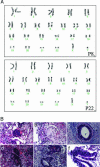Long-term self-renewal and directed differentiation of human embryonic stem cells in chemically defined conditions
- PMID: 16632596
- PMCID: PMC1458992
- DOI: 10.1073/pnas.0602280103
Long-term self-renewal and directed differentiation of human embryonic stem cells in chemically defined conditions
Abstract
Chemically defined medium (CDM) conditions for controlling human embryonic stem cell (hESC) fate will not only facilitate the practical application of hESCs in research and therapy but also provide an excellent system for studying the molecular mechanisms underlying self-renewal and differentiation, without the multiple unknown and variable factors associated with feeder cells and serum. Here we report a simple CDM that supports efficient self-renewal of hESCs grown on a Matrigel-coated surface over multiple passages. Expanded hESCs under such conditions maintain expression of multiple hESC-specific markers, retain the characteristic hESC morphology, possess a normal karyotype in vitro, as well as develop teratomas in vivo. Additionally, several growth factors were found to selectively induce monolayer differentiation of hESC cultures toward neural, definitive endoderm/pancreatic and early cardiac muscle cells, respectively, in our CDM conditions. Therefore, this CDM condition provides a basic platform for further characterization of hESC self-renewal and directed differentiation, as well as the development of novel therapies.
Conflict of interest statement
Conflict of interest statement: No conflicts declared.
Figures





Similar articles
-
Activin, BMP and FGF pathways cooperate to promote endoderm and pancreatic lineage cell differentiation from human embryonic stem cells.Mech Dev. 2011 Sep-Dec;128(7-10):412-27. doi: 10.1016/j.mod.2011.08.001. Epub 2011 Aug 10. Mech Dev. 2011. PMID: 21855631 Free PMC article.
-
Efficient definitive endoderm induction from mouse embryonic stem cell adherent cultures: a rapid screening model for differentiation studies.Stem Cell Res. 2014 Jan;12(1):166-77. doi: 10.1016/j.scr.2013.10.004. Epub 2013 Oct 23. Stem Cell Res. 2014. PMID: 24239964
-
Activin A maintains pluripotency of human embryonic stem cells in the absence of feeder layers.Stem Cells. 2005 Apr;23(4):489-95. doi: 10.1634/stemcells.2004-0279. Stem Cells. 2005. PMID: 15790770
-
The production and directed differentiation of human embryonic stem cells.Endocr Rev. 2006 Apr;27(2):208-19. doi: 10.1210/er.2005-0016. Epub 2006 Jan 24. Endocr Rev. 2006. PMID: 16434509 Review.
-
Culture development for human embryonic stem cell propagation: molecular aspects and challenges.Curr Opin Biotechnol. 2005 Oct;16(5):568-76. doi: 10.1016/j.copbio.2005.08.001. Curr Opin Biotechnol. 2005. PMID: 16099157 Review.
Cited by
-
Comparison of a xeno-free and serum-free culture system for human embryonic stem cells with conventional culture systems.Stem Cell Res Ther. 2016 Jul 30;7(1):101. doi: 10.1186/s13287-016-0347-7. Stem Cell Res Ther. 2016. PMID: 27474011 Free PMC article.
-
Human embryonic stem cells for brain repair?Philos Trans R Soc Lond B Biol Sci. 2008 Jan 12;363(1489):87-99. doi: 10.1098/rstb.2006.2014. Philos Trans R Soc Lond B Biol Sci. 2008. PMID: 17322002 Free PMC article. Review.
-
Wnt/beta-catenin/CBP signaling maintains long-term murine embryonic stem cell pluripotency.Proc Natl Acad Sci U S A. 2007 Mar 27;104(13):5668-73. doi: 10.1073/pnas.0701331104. Epub 2007 Mar 19. Proc Natl Acad Sci U S A. 2007. PMID: 17372190 Free PMC article.
-
High-throughput discovery of synthetic surfaces that support proliferation of pluripotent cells.J Am Chem Soc. 2010 Feb 3;132(4):1289-95. doi: 10.1021/ja906089g. J Am Chem Soc. 2010. PMID: 20067240 Free PMC article.
-
The potential of cell fusion for human therapy.Stem Cell Rev. 2006;2(4):341-9. doi: 10.1007/BF02698061. Stem Cell Rev. 2006. PMID: 17848721 Review.
References
-
- Thomson J. A., Itskovitz-Eldor J., Shapiro S. S., Waknitz M. A., Swiergiel J. J., Marshall V. S., Jones J. M. Science. 1998;282:1145–1147. - PubMed
-
- Reubinoff B. E., Pera M. F., Fong C. Y., Trounson A., Bongso A. Nat. Biotechnol. 2000;18:399–404. - PubMed
-
- Xu C., Inokuma M. S., Denham J., Golds K., Kundu P., Gold J. D., Carpenter M. K. Nat. Biotechnol. 2001;19:971–974. - PubMed
-
- Xu R. H., Peck R. M., Li D. S., Feng X., Ludwig T., Thomson J. A. Nat. Methods. 2005;2:185–190. - PubMed
-
- Wang G., Zhang H., Zhao Y., Li J., Cai J., Wang P., Meng S., Feng J., Miao C., Ding M., et al. Biochem. Biophys. Res. Commun. 2005;330:934–942. - PubMed
Publication types
MeSH terms
Substances
LinkOut - more resources
Full Text Sources
Other Literature Sources
Medical
Miscellaneous

